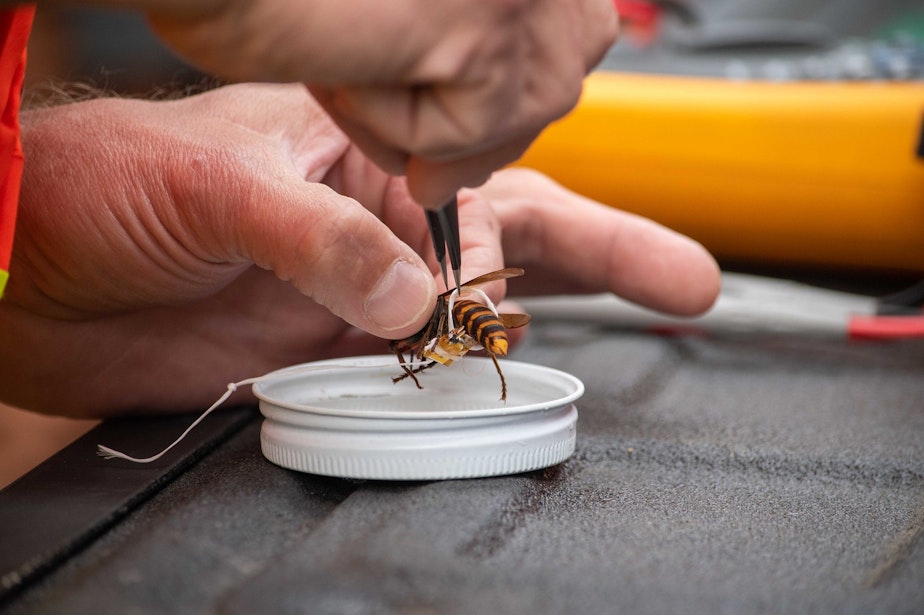Washington readies juice, rice wine, and other weapons to fight ‘murder hornets’

Washington state officials say they’ve upped their game and are determined to eradicate so-called "murder hornets" this year.
Asian giant hornet queens could start emerging from the ground any day now as spring draws near. The invasive hornets were first spotted in Whatcom County, in the state’s northwest corner, in 2019, shortly after the continent’s first sighting on Canada’s Vancouver Island.
Last year, Washington scientists hand-tied tiny transmitters onto the hornet queens with dental floss to track them back to their nests. This year, they say they’ll use high-strength Kevlar thread instead of dental floss.
RELATED: Surreal photos of the murder hornet hunt
“We had noticed one of the hornets we tied a tag to chewed it off as she was sitting just a few feet from our table,” Washington State Department of Agriculture entomologist Sven-Erik Spichiger said.
“It’s really annoying to tie a tag onto a hornet, so to watch her chew it off in a few seconds is disheartening,” Spichiger said.
Sponsored
Last year, entomologists used Bluetooth transmitters with a limited signal range and a lifespan of 12 hours before switching to VHF radio transmitters. This year, they plan to keep using VHF radio tags that can transmit long distances and last two weeks.
Spichiger said the improved technology should enable biologists to locate hornet queens and their nests faster than last year.
State officials plan to pepper northern Whatcom County with 1,500 traps – about one per square kilometer -- to lure and kill any murder hornets that may have survived last year’s eradication campaign.
After radio-tagging a hornet last fall near Blaine, just south of the Canadian border, state officials discovered and destroyed a nest with 200 giant hornet queens.
At a press conference Wednesday, Washington and British Columbia officials emphasized the importance of citizen scientists – members of the public – keeping an eye out for the nearly two-inch long hornets with an orange face and dark eyes.
Sponsored
Of 31 confirmed Asian giant hornet sightings in Whatcom County last year, half were called in by members of the public. All six Asian giant hornets documented in British Columbia last year were reported by the public.
It’s a bit easier to participate in trapping efforts this year. In addition to orange juice and rice wine, the preferred but somewhat pricey elixir used in hornet traps last year, they’re also recommending a cheaper brew of one part sugar and one part water.
British Columbia officials plan to work with beekeepers in the Fraser Valley, just north of Whatcom County, to trap and kill any hornets that survived the winter and last year’s eradication efforts.
“The border is an imaginary line,” said Paul van Westendorp with the British Columbia Ministry of Agriculture, Food and Fisheries. “This is a collective problem.”
The Fraser Valley is ringed on three sides by mountains and ocean, effective barriers to a hornet invasion, unlike the U.S.-Canada border to the south.
Sponsored
“I sympathize with my Washington friends because they have a much larger area, particularly further south, that could be conducive to successful establishment,” van Westendorp said.
“I assure you we will expend every effort and every resource that we have,” Spichiger said. “We are optimistic. We may not get them all, but we will get as many as we possibly can.”
Like other hornets, Asian giants will decapitate and remove the legs of bees and take their protein-rich torsos back to their nests to feed their young. The “apex predators” can decapitate whole honeybee hives and take a toll on the food crops the bees would have pollinated.
Biologists say it’s unlikely the bee-eating hornets would spread over the North Cascades into eastern Washington or beyond.
If control efforts fail, it’s more likely they would spread south toward Seattle and Oregon.
Sponsored
It’s unknown how the giant hornets arrived in this part of the world, though it is suspected a fertilized queen hitched a ride aboard a cargo ship from Japan or Korea.
Genetic differences between hornets trapped on Vancouver Island and Whatcom County suggest that the Asian giant hornets have managed to cross the ocean from more than one country and could do so again.
Spichiger said the tip to use Kevlar thread came from biologists on the island of Jersey off the coast of France.
The government of Jersey, in the Channel Islands between England and France, has been fighting a smaller bee-eating Asian hornet, Vespa velutina, since 2016.
That Asian hornet arrived in France in 2004 and has since spread to Spain, Portugal and Italy, decapitating honeybees as it goes.
Sponsored
Van Westendorp said European governments have spent 20 million Euros (US $24 million) to combat its spread with no success.
“That is a far more ominous threat,” he said.




